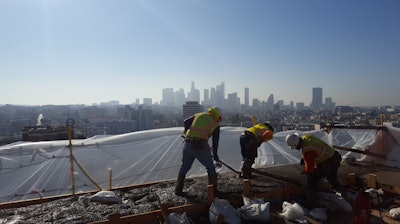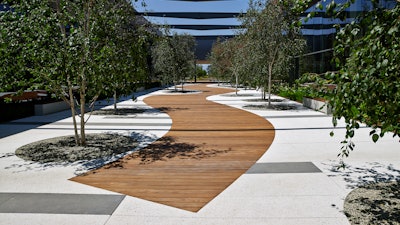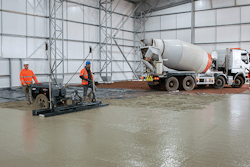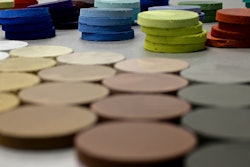
It’s a great time to explore business opportunities in the decorative concrete flatwork market. Known for its strength, attractive finishes, and sustainability qualities, decorative concrete flatwork has been steadily growing in popularity as a cost-effective option for homes, hotels, retail centers, entertainment venues, office buildings, and public works projects. Contractors already installing concrete flatwork may find it worthwhile to get the training and certifications necessary to offer quality decorative options.
While your company’s area of expertise may align well with expanding into decorative work, it takes time and financial resources to successfully enter the market.
A few drivers pushing the current decorative concrete flatwork market growth forward include:
- Project owners are realizing the value of applying texture, color, stamped patterns, or top surface retarders that expose aggregates to enhance the appearance of the walking or driving surfaces on their projects.
- Leveraging concrete flatwork’s durability and various finishing options, architects and landscape architects are creating designs and applications that are in turn rapidly expanding the use of decorative concrete.
- The introduction of top surface retarders in varying depth-of-etch capabilities has resulted in the growing acceptance of natural concrete appearances over other options.
 Formerly a U.S. Post Office facility, The Reserve in Playa Vista, Calif., is a 20-acre office campus that features sand-textured and seeded aggregate concrete paving, steps and walls at courtyards, plazas and walks. Work done by Trademark Concrete Systems.Trademark Concrete Systems
Formerly a U.S. Post Office facility, The Reserve in Playa Vista, Calif., is a 20-acre office campus that features sand-textured and seeded aggregate concrete paving, steps and walls at courtyards, plazas and walks. Work done by Trademark Concrete Systems.Trademark Concrete Systems
Specialized Skills
The proper placement and finishing of decorative concrete requires specialized skills in using products and techniques that are not required for most concrete placements. Applying top surface retarders, seeding aggregates on the surface of the concrete, and decorative sawcutting are all tasks that take detailed knowledge and care to complete with satisfactory results. In addition, the concrete mix design used often depends on the type of decorative application.
First and foremost, concrete contractors will need to train their office and field personnel in those distinctive skills needed for decorative applications. Expertise in decorative concrete goes beyond knowing how to use top surface retarders, color hardeners, integral color, stamping tools, release agents, and sealers. For instance, proper joint layout and panel sizes, and the ability to create consistent color and texture are all necessary for a successful decorative concrete flatwork project.
When it comes to concrete mixes, contractors should be aware of the effects that supplementary cementitious materials, such as fly ash, have on colors as well as the proper dosage rate and type of microfibers so as not to alter concrete aesthetics. They should know when air entrainment is needed and what types of problems they can expect to encounter when finishing concrete that is air entrained. Understanding how to use top surface retarders for decorative concrete and when admixtures should be used is also a necessity.
The list goes on.
Where to Get Training & Guidance
Many contractors get their feet wet by attending manufacturers’ training programs that introduce them to using specific decorative products. However, it’s also important to look to credible industry sources for more advanced education and guidance. Two organizations positioned to help contractors in the decorative concrete market are the American Society of Concrete Contractors (ASCC) and the American Concrete Institute (ACI).
The Decorative Concrete Council (DCC) is a specialty council of ASCC and the only professional organization dedicated to the decorative concrete industry. DCC provides educational resources—including technical documents and mentoring—and organizes discussions, training, and networking events. Members also have access to hotlines staffed by specialists who can answer questions about decorative concrete, polished concrete, concrete construction, safety, and insurance. Being able to connect with industry experts and network with decorative concrete contractors, manufacturers, and other interested parties is well worth the membership.
 American Concrete Institute’s Concrete Craftsman series of educational documents includes CCS-5(16) “Placing and Finishing Decorative Concrete Flatwork,” to help raise and maintain standards of quality in the decorative concrete flatwork industry.American Concrete Institute
American Concrete Institute’s Concrete Craftsman series of educational documents includes CCS-5(16) “Placing and Finishing Decorative Concrete Flatwork,” to help raise and maintain standards of quality in the decorative concrete flatwork industry.American Concrete Institute
Topics Covered in “Placing and Finishing Decorative Concrete Flatwork”:
- Mixture design for decorative concrete mixtures.
- The use of integral color and dry-shake color hardeners.
- The identification and uses of decorative finishing tools and equipment, such as stamping mats and stencils.
- The use of surface retarders to produce exposed aggregate surfaces.
- Stamping and texturing concrete.
- Seeding fresh concrete surfaces with decorative aggregate.
- Decorative treatments for stair treads and risers.
- Cleaning and sealing methods for decorative concrete.
The document also covers subjects that are universal to concrete flatwork construction, including jobsite and personal safety, ensuring designs adhere to Americans with Disabilities Act guidelines, preplacement site preparation and identification, and uses of concrete finishing tools.
Perhaps most important, “Placing and Finishing Decorative Concrete Flatwork” serves as source material for ACI’s Decorative Concrete Finisher certification programs.
 The motor court at Waldorf Astoria Beverly Hills in California consists of two colors of concrete in combination with natural stone to create a dramatic entry to the hotel. The decorative concrete flatwork project was completed by Trademark Concrete Systems and earned First Place for the Cast-in-Place - Special Finishes Over 5,000 sq. ft. from the Decorative Concrete Council in 2018.Trademark Concrete Systems
The motor court at Waldorf Astoria Beverly Hills in California consists of two colors of concrete in combination with natural stone to create a dramatic entry to the hotel. The decorative concrete flatwork project was completed by Trademark Concrete Systems and earned First Place for the Cast-in-Place - Special Finishes Over 5,000 sq. ft. from the Decorative Concrete Council in 2018.Trademark Concrete Systems
Get Certified
Recognizing the need to raise the quality of education to maintain high-level craftsmanship in the decorative concrete industry, the ACI introduced Decorative Concrete Flatwork certification to its programs in 2018. ACI's certification programs help contractors gain a competitive edge. Many local, state, national and international building codes, specifications, and agencies now, or will, require ACI-certified personnel on the jobsite. The training involved to get certified also ensures team members can consistently produce quality work, which in turn will help build your reputation in the market.
Contractors can have personnel certified as either a Decorative Concrete Flatwork Finisher or Decorative Concrete Flatwork Associate. While both certifications require individuals to complete a written exam and maintain current certifications as an appropriate ACI-Certified Concrete Flatwork Finisher or Technician, the Decorative Concrete Flatwork Finisher certification also requires 1,500 hours of work experience. (Editor's Note: For comparison, according to pilotinstitute.com, this is the same amount of hours it requires to become an airline transport pilot for those with only a commercial pilot license, no degree, and no military flight experience.)
The decorative exam covers basic knowledge of proper installation and finishing procedures for decorative concrete flatwork, including:
- Coloring: Applying and finishing dry-shake hardeners, finishing integral color.
- Stamping: Form layout, squaring formwork, pattern layout, release agents, texturing tools, finishing for texture applications.
- Exposed Finishes: seeding aggregate, finishing for top surface retarder applications, applying top surface retarders, washing the surface to expose aggregates.
- Stairs: forming, stamped finishes, exposed finishes, colored finishes.
- Cleaning/Sealing: applying curing compounds and sealers, surface preparation for sealers.
An ACI-Certified Decorative Concrete Flatwork Associate may upgrade to ACI-Certified Decorative Concrete Flatwork Finisher at any time during the five-year certification period by fulfilling the work experience requirements.
The work and education required to obtain these certifications will increase the knowledge base of finishers and associates, which will benefit contractors’ quality of work as well as their bottom line. What’s more, when you ensure your team members receive the proper guidance and training from trusted industry sources, the level of their craftsmanship will continue to progress.
To find certification sessions near you, check out the ACI Certification Sessions Calendar. The online calendar is updated as new instruction and testing sessions are scheduled.



















